A complete workshop for your team to see what’s a good test strategy
Teams often disagree about what is a good test strategy! So here is an all-in workshop to capture practices, define testing terms and agree on improvements.

One of the first teams I worked with as a full-time coach struggled with testing. Let’s call this team Phoenix. It was relying almost only on slow end-to-end tests. The team had just welcomed a few members to make it cross-disciplinary. In addition, the team aimed to speed up the testing feedback loop. So, developers were xUnit-testing while quality engineers were speeding up systems tests.
Around 2 years later, the situation had improved a lot. Developers were getting more confidence in their tests, and end-to-end tests were faster. Yet, the team was still relying on those slow tests. There was yet no coordinated effort towards an improved test strategy. As a result, the team had to overcome a new threshold to further improve their testing.
I also noticed that the team used its own DIY vocabulary for the different kinds of software tests:
- “TPKs” for end-to-end tests
- “offline tests” for any type of developers tests
One thing I’m still unclear on is what you mean by “Integration Testing: and whether it’s similar enough in meaning to what the rest of the folks mean by “integration testing”
I’ve learned to define testing terms before having testing conversations. At one large-sized company, engineers had different definitions for each testing term. E.g., one Pearson’s “integration” test was another person’s “integrated” test.
I agree that “integration Test” has a lot of meanings.
Blurry testing terms are a common symptom of not thinking about “What is a good test strategy for our team?” A lack of testing strategy leads to many problems, like:
- Holes in the test harness, which lead to bugs and rework
- A slow testing feedback loop, relying on old habits, like end-to-end integrated tests
- Increased test maintenance burden because different kinds of test overlap coverage.
With time, these “testing problems” increase the risk of abandoning testing altogether!
Wouldn’t it be great if engineers regularly aligned on testing terms?
Let’s teach a dedicated workshop to the teams!
Phoenix tackled testing issues with an all-in workshop to discuss the testing strategy. During the workshop, all team members were able to:
- Learn industry’s testing best practices and compare their own practices
- Agree and capture testing terms
- Agree about who, how, and when they should test the different aspects of their system
- As a whole team, define and plan an improvement to their testing strategy
Here is what they said about the workshop:
This workshop made me think about many things, thanks to the different questions.
Thanks to this workshop, I enriched my testing vocabulary with new words, such as subcutaneous tests.
It’s like a game; we had fun but also came up with new solutions.
I liked the fact that the whole team participated in the workshop.
More specifically, QA engineers and developers saw that some parts of the code were tested twice. It was clear that to reduce the testing feedback loop, they had to collaborate more. They had to start replacing end-to-end tests with developer tests. At the end of the workshop, they decided to write a first decoupled acceptance test.
A few months after the workshop, the team was now regularly removing end-to-end tests. As a result, developers could enjoy a faster testing feedback loop.
🎁 With better testing comes more sustainable and calmer work!
The Workshop Agenda
You might be wondering what was inside this workshop? Here is a summary of the steps that the Phoenix team went through. The workshop is a succession of 7 steps. All in all, it takes between 5 to 7 hours. Therefore, running this workshop as a series of 1-hour sessions is best.
Step 1: Learn what industry agile trailblazers do
Before the session, we sent homework to the team members. We shared links like:
- DevLin2017 - Aslak Hellesøy - Testable Architectures - YouTube
- 7 Reasons to Choose Consumer-Driven Contract Tests Over End-to-End Tests (reflectoring.io)
The homework was to search the web and these references for different kinds of software tests.
During the workshop, we asked each team member to present a kind of test. To illustrate this, they had to:
- Present a definition to the rest of the team
- And place it on this duration X maintenance X coverage quadrant.
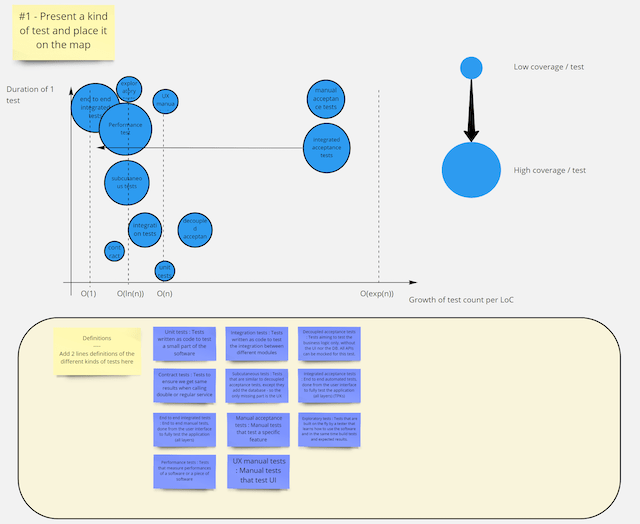
The idea is to learn how the different kinds of tests compare.
Step 2: Draw the ideal pyramid
With this new knowledge, team members could build an ‘ideal’ test pyramid.
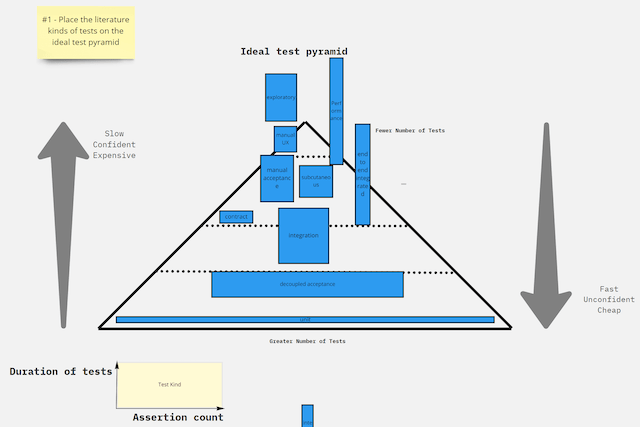
It’s funny that this ideal pyramid does not look too pyramidal. Martin Fowler said we should not bother so much about the shape anyway! There is no good-or-bad result. This step is yet another way for the team to apprehend different kinds of software tests.
Step 3: Draw your pyramid
After digging through their test metrics, the team could draw its own test pyramid. We sent the team more homework for this activity. We asked team members to come up with metrics:
- What are your different kinds of tests?
- What is the total execution time of each of these kinds of tests?
- How many assertions does each of these kinds of tests check?

This big rectangle in the middle represents end-to-end tests. It was clear to all the team members that they relied heavily on those!
Step 4: Compare and discuss
Participants had 2 pyramids and a better understanding of the test vocabulary. To continue, they could now map their tests to the industry’s standards.
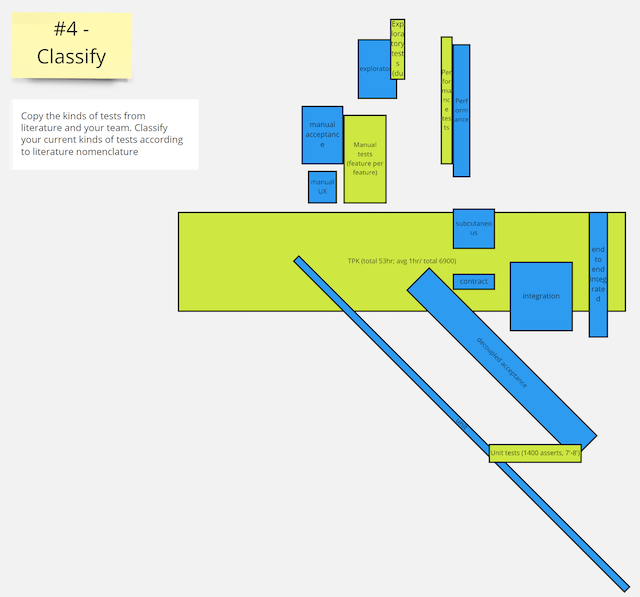
As you can see, they had to get creative! There is no one-to-one mapping between their tests and the kinds of tests we can find in the industry. This mapping showed how end-to-end tests verified too many aspects of the system.
The team members could now imagine what a good test strategy would be for them. Here are examples of what I heard during the workshop:
We are missing decoupled acceptance tests!
We won’t be able to remove end-to-end tests until we ensure coverage differently!
Step 5: Fill a test Strategy Canvas
The Test Strategy canvas is a one-page template that summarizes how a team tests its software.
One of the goals of this workshop is to agree on names for the different kinds of software tests. That’s done in this step. The Phoenix team members also agreed to a unique test strategy thanks to this activity. This canvas clarifies precisely:
- The purpose of testing in the team
- What is inside or outside the team’s responsibility
- The different kinds of tests: name, constraints, technologies, who runs and maintains them…
Having a whole team converge to a single canvas can look daunting! However, mixing the 1-2-4-all and asynchronous sessions is an effective way to do it.
Here is what the Phoenix canvas looked like:
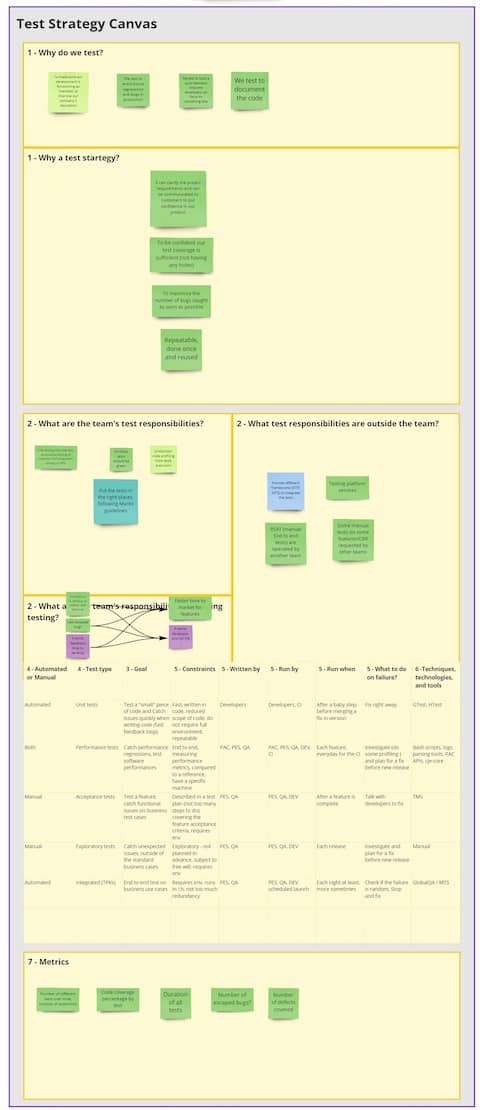
The grid you see in the middle of the canvas describes every different kind of test. As an example, here is the line for Unit Tests:

This canvas can also serve as a living convention. Fortunately, updating the workshop board should not be too long. Re-running the workshop is also a good onboarding activity for new joiners.
Step 6: Solution focus to get 1 step closer
At this point, all participants agreed on the current situation. They also knew the industry’s best practices. The next step was to go through a Solution-Focus activity to draft an improvement.
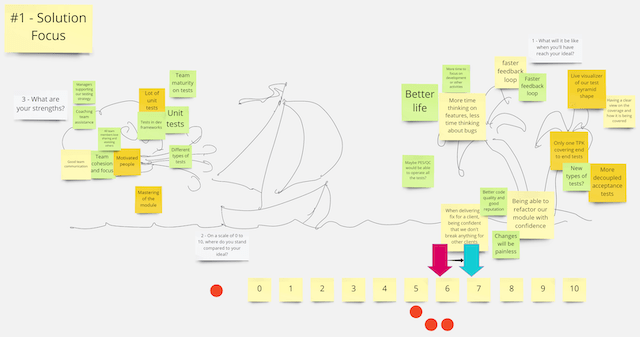
This activity constrains the size of improvements to something small and manageable. This lets the PO and the rest of the team find a compromise that:
- Delivers value early.
- Without blocking feature delivery.
- While still going in the right direction.
Step 7: Draft an improvement as a team!
The solution focus activity ends with participants brainstorming the “10% improvement”. Here is Phoenix’s improvement draft:
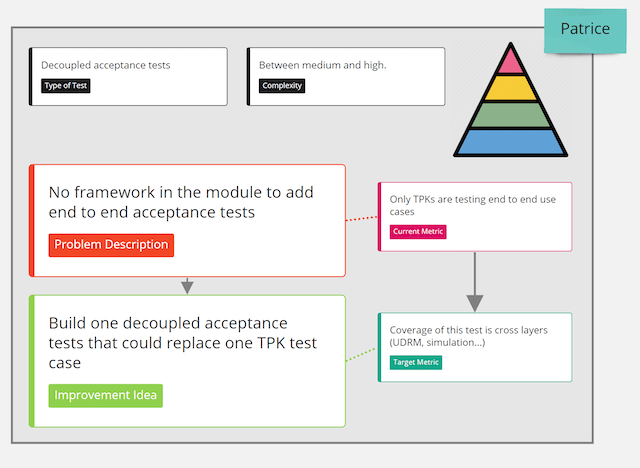 Final testing improvement the team agreed on.
Final testing improvement the team agreed on.
A key benefit of coming up with this improvement with the whole team is that it is already prioritized! During the workshop, the PO had all the time to build empathy with everyone. He understood how this improvement would make the team more efficient.
💡 A nice side effect is that putting tests in place often involves paying back technical debt!
This workshop was also a way to break silos and give non-developers a look inside the system.
To summarize, such technical whole-team workshops can show a different way:
💡 The way of communication, collaboration, and collective decision-making
Is your test strategy clear?
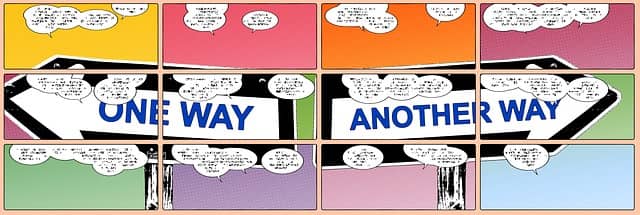
Did you notice any miscommunication around testing between team members?
- Do they disagree about testing terms, how to test, or how to improve testing?
- Do the different profiles in the team disagree about the priority to give to testing?
If any of these is true, run this Test Strategy Workshop! Find someone interested in facilitating the workshop and help them the first time. They should be able to re-run it later for an update. Running this workshop now and again will result in continuous improvement in testing.
What about you? I’d love to read about other coaching techniques to handle testing disagreements! Finally, if you try this workshop, please comment on how it went or what could improve it.
If you liked this post, you might also be interested in:
- How to make a team facilitate agile architecture workshops
- How to help a team to find their preferred mob programming rules?
- 5 Whole-Team Workshops To Increase Developers’ Role In Sprint Planning
- 3 Good and Bad Ways to Write Team Coding Standards and Conventions
- How We Started Exploratory Testing




Leave a comment